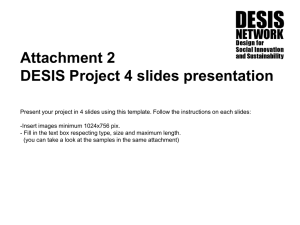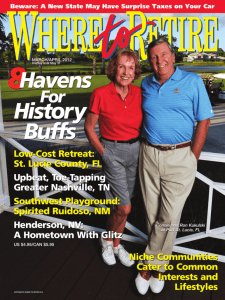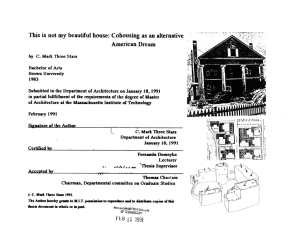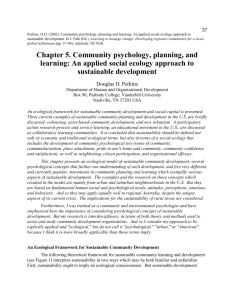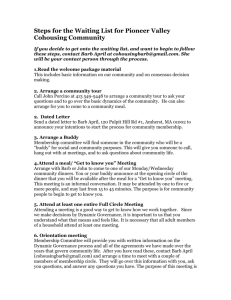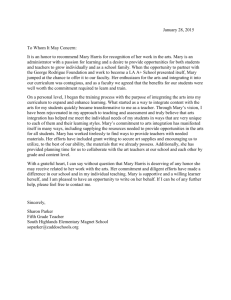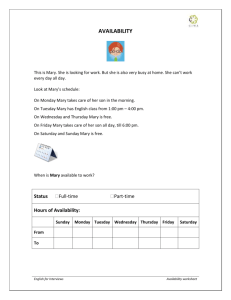Cohousing on Abbott Rd. Minutes July 23 Core Group Meeting
advertisement
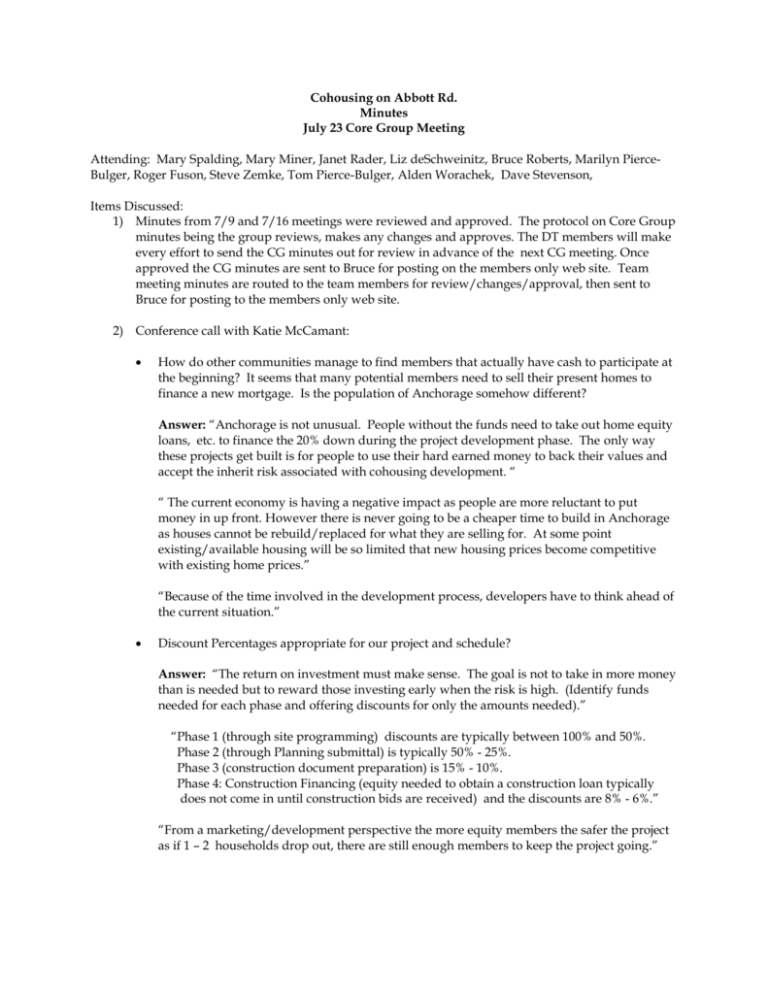
Cohousing on Abbott Rd. Minutes July 23 Core Group Meeting Attending: Mary Spalding, Mary Miner, Janet Rader, Liz deSchweinitz, Bruce Roberts, Marilyn PierceBulger, Roger Fuson, Steve Zemke, Tom Pierce-Bulger, Alden Worachek, Dave Stevenson, Items Discussed: 1) Minutes from 7/9 and 7/16 meetings were reviewed and approved. The protocol on Core Group minutes being the group reviews, makes any changes and approves. The DT members will make every effort to send the CG minutes out for review in advance of the next CG meeting. Once approved the CG minutes are sent to Bruce for posting on the members only web site. Team meeting minutes are routed to the team members for review/changes/approval, then sent to Bruce for posting to the members only web site. 2) Conference call with Katie McCamant: How do other communities manage to find members that actually have cash to participate at the beginning? It seems that many potential members need to sell their present homes to finance a new mortgage. Is the population of Anchorage somehow different? Answer: “Anchorage is not unusual. People without the funds need to take out home equity loans, etc. to finance the 20% down during the project development phase. The only way these projects get built is for people to use their hard earned money to back their values and accept the inherit risk associated with cohousing development. “ “ The current economy is having a negative impact as people are more reluctant to put money in up front. However there is never going to be a cheaper time to build in Anchorage as houses cannot be rebuild/replaced for what they are selling for. At some point existing/available housing will be so limited that new housing prices become competitive with existing home prices.” “Because of the time involved in the development process, developers have to think ahead of the current situation.” Discount Percentages appropriate for our project and schedule? Answer: “The return on investment must make sense. The goal is not to take in more money than is needed but to reward those investing early when the risk is high. (Identify funds needed for each phase and offering discounts for only the amounts needed).” “Phase 1 (through site programming) discounts are typically between 100% and 50%. Phase 2 (through Planning submittal) is typically 50% - 25%. Phase 3 (construction document preparation) is 15% - 10%. Phase 4: Construction Financing (equity needed to obtain a construction loan typically does not come in until construction bids are received) and the discounts are 8% - 6%.” “From a marketing/development perspective the more equity members the safer the project as if 1 – 2 households drop out, there are still enough members to keep the project going.” “The construction lender is not going to want investors to take all funds out if there are still unsold units. So people who want to take out over 20% of funds invested ( for down payment or other ) may not be able to do so.” “ If 70% - 75% of the units are sold, this will take care of the construction loan, and allow those investors who have put more than 20% to take those funds out and put them towards a home mortgage, or other use.” “ If there is a development partner they could obtain the construction loan and will typically charge a percentage fee for this.” “Once the planning approvals are obtained Katie can assist us in preparing a financing package to use in negotiating with the banks or a development partner.” Tension between need to maintain a schedule vs need to get to know each other and develop trust. How do other cohousing groups deal with this? Answer: “This tension is normal. Real money is on the line and real decisions make for a more intense situation. The Abbott project now owns 1 parcel and has a 15 month option to purchase the 2nd parcel needed to proceed with the project. This is a different situation from pre-land acquisition when the discussions are much more theoretical.” “Other communities insure that all committees keep minutes which are posted on the members only web site, have strong committees that are delegated authority and the Finance team provides quarterly reports to the CG.” “ The CG meeting time is most valuable and best spent on big picture items only. Teams do the detailed work. Typically the Teams (Development, L&F, Marketing, Social provide the CG with very short reports. Marketing, what have other groups found to be successful? Answer: “ Where is the marketing at on the Abbott project? What’s been done to date?” “Other groups have done the following: E-newsletter, build data base, look for opportunities in the community to talk about cohousing, talk with people you know, keep the web page updated, drive traffic to the web site” Is there a table available that defines the differences between commune, condo’s and cohousing? Answer: “ Check FAQ’s at cohousing sites on line.” Do other groups have particularly effective communication strategies that work for them? Answer: “ Broad goals are what need to be defined in Core Group meetings. Detailed work needs to happen in team meetings and by the individuals (architect and project manager).” “Other groups use list serve for ongoing discussion. Clear ground rules are needed to avoid overwhelming members with messages that do not further discussion (good thought, I agree, thanks, etc). List serves are good for information sharing and discussion but not for decision making. List serves also do not store documents, so a minutes record/file on the members only web page is still needed for storing historical information. Originally a senior housing complex (SHC) was included in the budget. What is the status of this? Answer: Mary M: “The budget originally allocated a portion of the land purchase to a future SHC. A SHC is not being planned at this time and the full cost of the land has been included in the current project budget.” Have any of the projects you have worked on included lower-cost efficiencies, or units that don’t have full kitchens? I understand that is some cases one-bedroom units didn’t sell well. Is this usually the case, or just something that can sometimes happen? How often has this happened in your experience? Are there projects with multiple smaller units that have worked out? What are the factors that you think led to their success or failure in particular cases? Answer: “Yes”. In Katie’s experience, the lower-cost efficiencies have sold quickly. In checking with other cohousing groups in Maine and Mass. we were told that the small units were the last to sell. Per discussion with Anchorage developers, (Glenn Gellert & Bob Peterson) they don’t build the smaller units as the cost is not that much less than a larger unit and the smaller ones are harder to sell. Per Katie “ People are usually shocked at the price of smaller units as a small 1 bedroom is often only $20,000 cheaper than a larger 2 bedroom, 50% of unit costs are the same regardless of the square footage”. It’s possible to build units without full kitchens but difficult to get financing for them. The getting it built workshop described a number of committees, including a design committee. In the absence of a development team, how would any unresolved issues remaining after each design workshop be managed. E.g. There was substantial design work done by our development team to make a site plan after the site planning workshop before we as a group finally settled on a plan. If we hadn’t had a development team working on this, how would these design issues have been worked out? Is the design committee intended exclusively to work on researching alternate materials to those chosen by the architect after the final workshop unit design workshop has happened? Answer: “Chuck and I do not complete a design program without coming to closure on the deliverable. The local architect then works with the group on any small changes that are needed to meet local code requirements. ” “The design committee forms after all the design workshops are done and responds to proposals by the architect, on interior finishes or fixtures.” An example of this might be if the architects propose a linoleum flooring and members would like marmoleum. The design team would research the differences and either make a decision or recommendation back to the CG. 3) Finance Report: Postponed to next meeting as Alden had to leave early. 4) July 30th presentation: CG recommended that we include: A simple/clear discussion of how the development process works in our cohousing (owner developers) and what the discounts are. Renderings of the site layout and proposed buildings to show, Cohousing books for sale. Mary M. agreed to coordinate ordering of the books. A survey similar to the one at the April museum presentation. Mary M. to prepare. Marilyn provided Extra Posters and flyers for posting. 5) A suggestion was made that for marketing purposes CG members identify units they intend to purchase as being “sold”. Concern was expressed at the meeting with this process as not all CG members were present. Additional concern was expressed after the meeting regarding labeling units as sold as being disingenuous. At the present none of us have actually put in a 20% down payment and associate members have not put any money towards payment of a unit. Site selection is one of the most personal, complex and lasting decisions each family will make. It’s recommended that the process team come up with a method of unit selection that includes mitigation when two or more families prefer the same unit. 6) Next CG Meeting: August 7th, AUUF 6:30 – 8:30pm 7) Meeting Evaluation: Use colored cards to get group more familiar with them which will also help orient new members. Use egg timer to keep agenda on schedule Teams to provide 1 minute summary of activities July 31st backside Flattop hike with Mary Kraus. For those who don’t know where to go, come to the Miners and carpool. If raining, August 1st instead.
